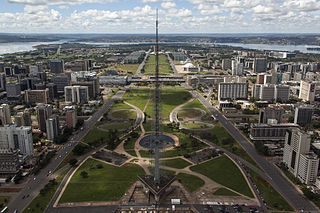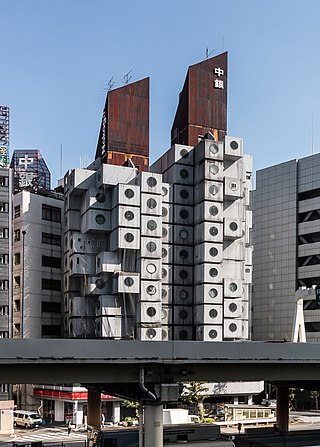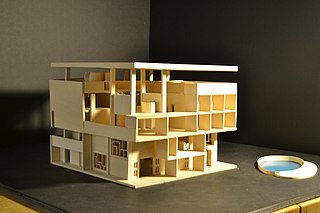
Charles-Édouard Jeanneret, known as Le Corbusier, was a Swiss-French architect, designer, painter, urban planner and writer, who was one of the pioneers of what is now regarded as modern architecture. He was born in Switzerland and acquired French nationality by naturalization on 19 September 1930. His career spanned five decades, in which he designed buildings in Europe, Japan, India, as well as North and South America. He considered that "the roots of modern architecture are to be found in Viollet-le-Duc".

Villa Savoye is a modernist villa and gatelodge in Poissy, on the outskirts of Paris, France. It was designed by the Swiss-French architect Le Corbusier and his cousin Pierre Jeanneret, and built between 1928 and 1931 using reinforced concrete.

Urban design is an approach to the design of buildings and the spaces between them that focuses on specific design processes and outcomes. In addition to designing and shaping the physical features of towns, cities, and regional spaces, urban design considers 'bigger picture' issues of economic, social and environmental value and social design. The scope of a project can range from a local street or public space to an entire city and surrounding areas. Urban designers connect the fields of architecture, landscape architecture and urban planning to better organize physical space and community environments.

Originating in ancient India, Vastu shastra is a traditional Hindu system of architecture based on ancient texts that describe principles of design, layout, measurements, ground preparation, space arrangement, and spatial geometry. The designs aim to integrate architecture with nature, the relative functions of various parts of the structure, and ancient beliefs utilising geometric patterns (yantra), symmetry, and directional alignments.

The International Style or internationalism is a major architectural style that was developed in the 1920s and 1930s and was closely related to modernism and modernist architecture. It was first defined by Museum of Modern Art curators Henry-Russell Hitchcock and Philip Johnson in 1932, based on works of architecture from the 1920s. The terms rationalist architecture and modern movement are often used interchangeably with International Style, although the former is mostly used in the English-speaking world to specifically refer to the Italian rationalism, or even the International Style that developed in Europe as a whole.

Modern architecture was an architectural movement and style that was prominent in the 20th century, between the earlier Art Deco and later postmodern movements. Modern architecture was based upon new and innovative technologies of construction ; the principle functionalism ; an embrace of minimalism; and a rejection of ornament.

Metabolism was a post-war Japanese biomimetic architectural movement that fused ideas about architectural megastructures with those of organic biological growth. It had its first international exposure during CIAM's 1959 meeting and its ideas were tentatively tested by students from Kenzo Tange's MIT studio.
Starchitect is a portmanteau used to describe architects whose celebrity and critical acclaim have transformed them into idols of the architecture world and may even have given them some degree of fame among the general public. Celebrity status is generally associated with avant-gardist novelty. Developers around the world have proven eager to sign up "top talent" (i.e., starchitects) in hopes of convincing reluctant municipalities to approve large developments, of obtaining financing or of increasing the value of their buildings. A key characteristic is that the starchitecture is almost always "iconic" and highly visible within the site or context. As the status is dependent on current visibility in the media, fading media status implies that architects lose "starchitect" status—hence a list can be drawn up of former "starchitects".

Urban morphology is the study of the formation of human settlements and the process of their formation and transformation. The study seeks to understand the spatial structure and character of a metropolitan area, city, town or village by examining the patterns of its component parts and the ownership or control and occupation. Typically, analysis of physical form focuses on street pattern, lot pattern and building pattern, sometimes referred to collectively as urban grain. Analysis of specific settlements is usually undertaken using cartographic sources and the process of development is deduced from comparison of historic maps.
Megastructure is an architectural and urban concept of the post-war era, which envisions a city or an urban form that could be encased in a massive single human-made structure or a relatively small number of interconnected structures. In a megastructural project, orders and hierarchies are created with large and permanent structures supporting small and transitional ones.

Deconstructivism is a postmodern architectural movement which appeared in the 1980s. It gives the impression of the fragmentation of the constructed building, commonly characterised by an absence of obvious harmony, continuity, or symmetry. Its name is a portmanteau of Constructivism and "Deconstruction", a form of semiotic analysis developed by the French philosopher Jacques Derrida. Architects whose work is often described as deconstructivist include Zaha Hadid, Peter Eisenman, Frank Gehry, Rem Koolhaas, Daniel Libeskind, Bernard Tschumi, and Coop Himmelb(l)au.
Colin Rowe was a British-born, American-naturalised architectural historian, critic, theoretician and teacher. He is acknowledged to have been a major theoretical and critical influence in the second half of the twentieth century on world architecture and urbanism. During his life he taught briefly at the University of Texas at Austin and, for one year, at the University of Cambridge in England. For most of his life he was a professor at Cornell University in Ithaca, New York. Many of Rowe’s students became important architects and extended his influence throughout the architecture and planning professions. In 1995 he was awarded the Gold Medal by the Royal Institute of British Architects, its highest honor. He was also awarded the Athena Medal from the Congress for the New Urbanism posthumously in 2011.
Bernhard Hoesli (1923–1984) was a Swiss architect and collage artist.
Feminist theory as it relates to architecture has forged the way for the rediscovery of such female architects as Eileen Gray. These women imagined an architecture that challenged the way the traditional family would live. They practiced architecture with what they considered feminist theories or approaches. The rediscovery of architecture through feminist theory is not limited to female architects. Architects like Le Corbusier and Adolf Loos have also had their architecture reexamined through feminist theory.

Ville radieuse was an unrealised urban design project designed by the French-Swiss architect Le Corbusier in 1930. It constitutes one of the most influential and controversial urban design doctrines of European modernism.

Junzo Sakakura was a Japanese architect and former president of the Architectural Association of Japan.

Villa Shodhan is a modernist villa located in Ahmedabad, India. Designed by the Swiss architect Le Corbusier, it was built between 1951 and 1956. Building on his previous projects whilst integrating the traditional features of Ahmedabad design, the villa symbolizes Le Corbusier's domestic architecture. The building is currently used as a private residence.

Contextual architecture, also known as Contextualism is a philosophical approach in architectural theory that refers to the designing of a structure in response to the literal and abstract characteristics of the environment in which it is built. Contextual architecture contrasts modernist architecture, which value the imposition of their own characteristics and values upon the built environment.

Delirious New York: A Retroactive Manifesto for Manhattan is a 1978 book, written by Dutch architect Rem Koolhaas. The book serves as a retroactive manifesto for Manhattan between 1850 and 1960, analyzing the development of architecture and urban design throughout New York's history from the founding of New Amsterdam by the Dutch, to the design of the Headquarters of the United Nations by Le Corbusier. Rem Koolhaas describes the concept of 'Manhattanism', the theory of the creation and functioning of the city of New York, at length in the book.
Finding Lost Space: Theories of Urban Design is an architecture book by Roger Trancik, an educator and practitioner of urban design. The book has been translated into "simple" as well as "orthodox" Chinese translations. This book introduces the theory, vocabulary and issues of urban spatial design. It identifies and introduces the issue of ‘Lost Spaces’ that had emerged in the cities with the modern urban development and growth. The book was intended primarily for designers and students of the city. The book includes theoretical and critical discussion along with practical applications and strategies for correcting the problems of spatial structure.















